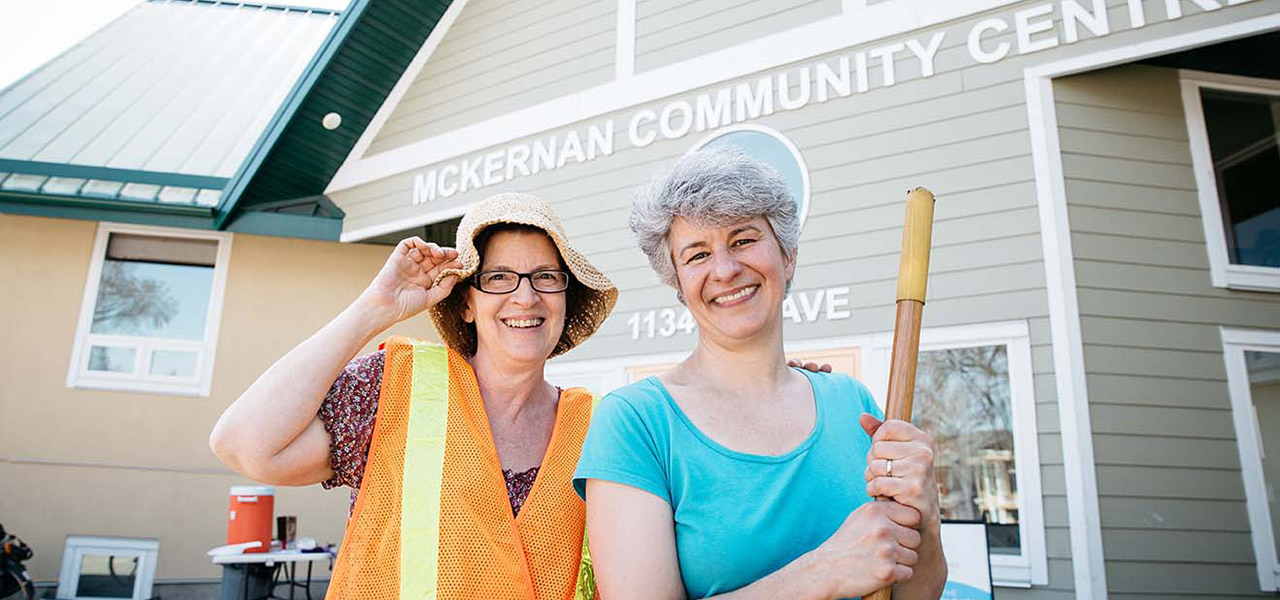
In many ways, McKernan is the quintessential Edmonton neighbourhood. Its post-war architecture, tree-lined streets and close proximity to the University of Alberta make McKernan a welcoming and desirable place to call home.
There is at least one thing, however, that sets McKernan far apart from many of its Edmontonian counterparts: the stunning McKernan Community Hall, located kitty-corner to the busy McKernan-Belgravia LRT station. Whether hosting weddings or board meetings, yoga or ecstatic dance, the hall serves more than 1,100 households in the McKernan area, as well as renters coming from farther afield. But the impressive hall, with its high ceilings, large windows and solar panels, was once a very different place.
Initially constructed in the 1950s, the hall served generations of McKernan residents as a centre for community gatherings. Since 1987, it was home to the McKernan Child Care Society’s out-of-school care program, and it also served as the backdrop for many a family celebration, holiday gathering or. But time took its toll on the building, and by the early 2000s, it became apparent that significant renovations were in order.
In 2006, mold and water damage were discovered in the building’s basement walls, due in part to the building’s poorly insulated roof. Without a serious intervention, it could not continue to operate as the heart of the community, particularly if it was going to serve as a daycare facility.
“The building was essentially crumbling before us at that point,” says Roberta Franchuk, the current president of the McKernan Community League. Although she took on the role of president several years after the damage had been discovered, she is well aware of the impact of those first few years. “At the beginning, this project seemed insurmountable. We weren’t expecting something like this.”
“Something like this” became a massive overhaul of the building. At the time, the Community League had three options: to patch together the hall’s crumbling walls, to undergo extensive renovations, or to close the building entirely.
Not wanting to give up on their local hub, Community League members began looking for ways to salvage the building. They approached engineering and architecture firms, and began fundraising to pay for what was likely to be an expensive job. They began working casino nights and looking for community grants. It was going to take time, but they were determined.
The community’s vision for the building was ambitious, aiming to create a completely accessible and environmentally-friendly space. But these big dreams came with a hefty price tag of $560,000. A large sum, but a manageable one.
“As a smaller community league, we were used to budgeting in the thousands of dollars,” says Franchuk. “When we started to realize how much needed to be done, it was really terrifying to think about how we could ever accomplish it.”
To help manage costs and mitigate the effect of such a significant outlay, the League aimed to complete the work in phases. They also approached the McKernan Child Care Society and the Alberta AdaptAbilities Association to look at long-term rental and partnership possibilities. While the McKernan Child Care Society had previously been housed in the hall, AdaptAbilities was a young and fast-growing organization looking for rental space in the area. For both groups, a long-term rental at the Community Hall could be a win-win.
With casino money slowly but steadily flowing in, and new tenancy agreements in place, things were looking up. That is, until, it became clear that more work would be needed to salvage the building’s crumbling foundation, and costs began to add up. With the cost of the project quickly ballooning to more than $1.3 million, members of the League began to worry. Grants from the federal, provincial and municipal governments had helped to move the project along, but a cost overrun this large had the potential to put an end to the project.
Fortunately, they learned of SEF.
“This project was such that, because of the nature of community leagues, we couldn’t go to a bank,” says Roberta. “We knew we would eventually be able to pay this money back, but we needed something to help us finish and pay for the construction. But because we were able to access the SEF financing, we were able to develop a plan to get to where we were going in a way that we could still manage the costs.”
Today, the Hall is busier than ever. With crowds of parents and families visiting the Adaptabilities and McKernan Child Care Society’s facilities each day, it’s clear that the building has retained its place as the beating heart of this community.
SVI Alberta is a conference held in Alberta where entrepreneurs, impact venture leaders, and changemakers gather to build their network and learn from each other through sharing experiences in a safe and supportive space.
Edmonton 3 October 2024 The Edmonton Community Foundation today announced the appointment of Ryan Young as the Director of the Social Enterprise Fund.
After thirteen years in the Executive Director chair at SEF, it is time for me to move on.